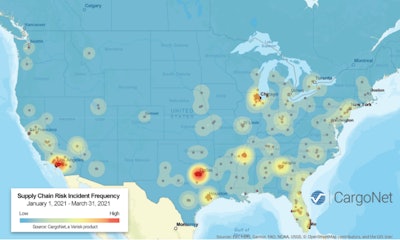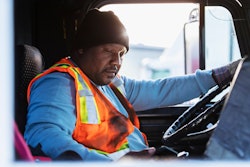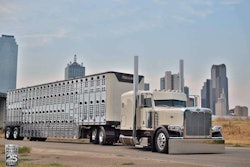“For the first quarter of 2021, cargo theft is down a little bit over 2020, but in 2020, we saw significant increases,” said Scott Cornell, National Transportation Practice Lead at Travelers. “While you’re down over 2020, you’re still up.”
Based on numbers from cargo theft recording firm CargoNet, theft incidents were up 29% in 2020 compared to 2019. The first quarter of 2020 saw 17% more thefts than the same period in 2019, while theft in the second quarter skyrocketed 63% year-over-year.
Cornell said one thing that’s certain with cargo thieves is that “they take advantage of the worst times for everybody else.” A similar increase was seen during the economic downturn in 2008, so seeing thieves take advantage of the COVID-19 pandemic wasn’t unexpected, he added.
[Related: Recorded cargo theft incidents, average values increased in 2020]
Before 2008, Cornell said thieves targeted high-dollar shipments like TVs, tablets, phones and electronics, because those were the items people were frequently buying.
“The cardinal rule with cargo thieves is that they will steal what they know they can sell,” he said. “We hit the economic downturn and by 2010, we saw food and beverage become the number one stolen commodity. We know that, at that time, they made that switch because of the economic downturn. When people are concerned about that type of thing, they get back to the basics. They’re going to feed themselves, house themselves, clothe themselves, and wait and see when things get better and kind of let the storm go by.”
Cornell added that after 2010, thieves realized food and beverage was easier to steal and get rid of because once they sell it, it’s consumed. It’s hard to find, and even if it is found, it often has to be destroyed for safety reasons.
“Chicken doesn’t have a barcode, you’re not registering a warranty or hooking it to the Internet, so it’s harder to trace,” he said.
Just like the shift that followed the 2008 recession, thieves also pivoted during the coronavirus-fueled economic downturn last year, focusing more on household goods. With many people working from home during the pandemic, more people started to remodel their homes, which led to the rise in theft of household goods.
Thieves use a variety of tactics to steal goods from trucks, but the most common type of theft is pilferage – when thieves break into a trailer and steal a couple boxes or part of a pallet of goods. Unless a driver is doing a walk-around of their truck each time they stop en route to their destination, Cornell said pilferage can be difficult to detect. If it’s not noticed right away, it can be hard to determine where the theft occurred, so fleets don’t know which law enforcement agency to contact.
[Related: Drivers play a key role in load security]
One type of theft that Cornell said has increased in the last six to eight months has been through identity theft. Cargo theft groups will steal the identity of companies to put in purchase orders for cargo and have it shipped to locations they control. They will then move that freight themselves.
When it comes to protecting your fleet from becoming a victim of cargo theft, Cornell said Travelers works with its clients to have a layered approach, starting with making sure your employees, including drivers, dock workers and others, understand and are aware of cargo theft.
Beyond that, he added, is having processes and procedures in place to further deter thieves from accessing your equipment – things like not parking trucks in unsecured lots, or using theft prevention devices on the tractor and/or trailer.
Another good practice, Cornell said, is to have a “red zone policy” that requires your drivers to be fueled and have enough hours to get at least 250 miles away from their pickup location – a deterrent for thieves attempting to follow them until they park.
“We know that cargo thieves will do surveillance on distribution centers and warehouses, and they’ll follow the drivers out in hopes that the driver will stop for their fuel or their rest a short distance after the stop,” he said. “Do they sometimes still sometimes follow that far? Sure, but not the majority of the time. You’re going to eliminate a good number of those opportunities.”
The next layer is the addition of technology, including tracking in the trailer and/or cargo, using geofencing when parking and more.
Finally, fleets should have a process for reporting theft in the event that it occurs, which includes alerting their insurance carrier and the police in the jurisdiction where the theft took place.
 Cargo theft decreased slightly in the first quarter of 2021 compared to the same quarter a year ago, but theft activity is still considerably higher than before the pandemic.
Cargo theft decreased slightly in the first quarter of 2021 compared to the same quarter a year ago, but theft activity is still considerably higher than before the pandemic.












